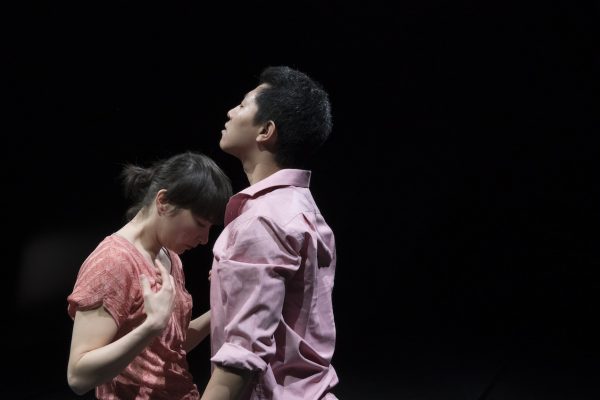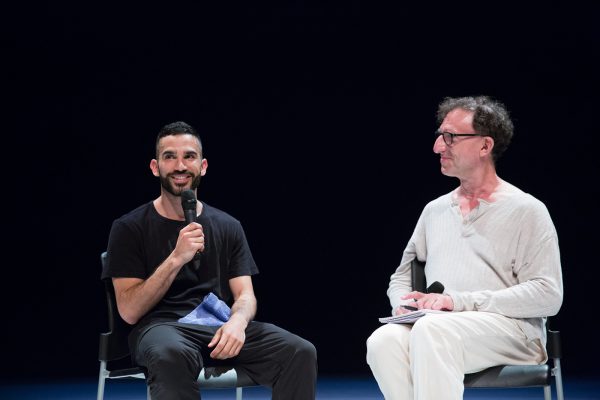At first glance, they aren’t very suitable neighbours. The National Ballet of Canada closed its 2017/2018 season with a mixed program of ballets including the Canadian premiere of recent Tony Award–winner Justin Peck’s Paz de la Jolla, the celebrated James Kudelka masterpiece The Man in Black, and the unusual and unforgettable Cacti by Alexander Ekman. A performance experience that begins in a real-life, tangible setting, ends in a timeless, abstract realm. Yet, the odd creations in Cacti somehow seem more relatable than the dream-like figures in Paz de la Jolla.
A picturesque summer Saturday in Toronto provided the perfect primer for Justin Peck’s whimsical ballet, Paz de la Jolla. The curtain rises on a stage of energetic dancers clad in bright-pastel beach outfits – transporting the viewer to an idealized version of a summer beach party. Like a Hollywood fantasy, the ballet’s bubbling energy reflects this atmosphere. Peck’s choreography features sharp movements, repeated sequences that mimic the minimalist passages in Bohuslav Martinů’s Sinfonietta la Jolla, and an overabundance of spins and lifts – an ode to the joy of youth in summer.
In the ballet, a young couple (danced on opening night by the spectacular dancers Hannah Fischer and Harrison James), meets serendipitously on a beach. The busy commotion of the first few minutes perfectly captures the rush of “love at first sight,” with James literally leaping from a line of male dancers to find his new love. Fischer’s ethereal grace mixes with James’ natural charisma, creating a striking pair who establish an aura of serene dreaminess.
Peck based the ballet on his memories of his home state of California and which translate in everything presented on stage, from the luminous costumes by Reid Bartelme and Harriet Jung to the gorgeous blankets of light designed by Mark Stanley. Every element of the design grounds one in a specific setting, yet the dancers feel out of reach – like figures from a dream.
The evening’s dream continues in the resurrected voice of the late, great Johnny Cash in The Man in Black. On a bare stage, four dancers begin their haunting tribute. Pairing Kudelka’s choreography with a soundtrack from the later part of Cash’s career creates an irresistible dynamic, as the continuous motion of the dance clashes against the slowing cadence of Cash’s gravel voice.
On stage, three men and one woman pulse in and out of various tableaux, their faces never shifting from neutral, their bodies expressing the emotion in the music. Very few moments of pure classical structure appear in the dancing, if any. Kudelka instead incorporates a mix of line dancing, acrobatics and contemporary steps – with his dancers kicking, stomping, trotting, lifting each other and slapping their thighs. The combination of Cash’s emotive singing and the dancers’ expressive movement causes quite a visceral reaction throughout the audience, with several people wiping away tears by the end.
Among the dancers, Francesco Gabriele Frola makes a remarkable impression. While the three others dance the steps extremely well, Frola inhales the emotion of the dance, transforming his body within the context of the choreography and ultimately demonstrating the star allure required from a principal dancer.
Finally, with Ekman’s Cacti, we depart the human world for an abstract plane of witty musings and unrestrained exploration. Dressed in matching androgynous costumes, the ensemble begins a symphony of sound, collaborating with four soloists from the orchestra in a wild creative playground. Set in a timeless, monochromatic void lit by aggressively precise lighting, the ebb and flow of gorgeous baroque music meets the animalistic huffing, puffing and pounding of the dancers.
A jaw-dropping, “mind-reading” pas de deux was the highlight of the evening. As the dancers begin their choreography, an audio track echoes through the hall, representing the dancers’ thoughts. The piece generated one of the most enthusiastic responses I have ever seen from a ballet audience. Of the evening’s three works, Cacti is by far the most removed from reality, but it remains entirely mesmerizing and extraordinarily relatable. As the program journeyed from the physical to the abstract, so the audience travelled from the distant dream in Paz de la Jolla to the wacky portrayal of intrinsically human processes in Cacti.
The National Ballet of Canada performs Paz de la Jolla, The Man in Black and Cacti from June 16 through June 22 at the Four Seasons Centre for the Performing Arts, Toronto, ON.





